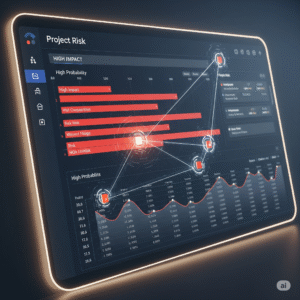In today’s hyper-competitive business landscape, project managers are juggling more than ever before. Complex projects, distributed teams, tight deadlines, and mountains of data have become the norm. The traditional methods of Gantt charts and manual status updates, while still valuable, are often not enough to keep pace. This is where a groundbreaking shift is occurring, driven by a technology that is redefining efficiency and strategic oversight: artificial intelligence. The integration of AI project management is no longer a futuristic concept; it’s a practical reality that is empowering teams to work smarter, faster, and more predictively.
But what does this new frontier of AI project management actually look like? It’s not about robots replacing project managers. Instead, think of AI as the ultimate intelligent assistant—a co-pilot that handles the repetitive, data-heavy lifting, freeing up human leaders to focus on what they do best: strategy, creative problem-solving, and team motivation. This article will explore the profound impact of AI on project management, from automating mundane tasks to providing deep predictive insights that drive success. We’ll look at real-world examples, powerful tools you can start using today, and a practical roadmap for implementation.
What Exactly is AI Project Management?
At its core, AI project management involves leveraging artificial intelligence, machine learning, and data analytics to enhance and automate various stages of the project lifecycle. Unlike traditional software that simply follows pre-programmed rules, AI-powered systems can learn from data, identify patterns, make predictions, and even suggest optimal courses of action. It’s the difference between a simple calculator and a sophisticated financial advisor. One gives you answers to your inputs, while the other analyzes market trends to recommend an investment strategy.
This technology transforms project data from a passive record of what has happened into an active, predictive asset that guides what should happen next. Whether it’s analyzing past project timelines to forecast a more accurate completion date for a current one or identifying a potential budget overrun before it occurs, AI adds a layer of intelligence that was previously unattainable. This shift is fundamental to modern operations, enabling a more proactive rather than reactive approach to handling challenges.
The Core Benefits of Integrating AI Project Management
The “why” behind adopting AI project management is compelling. Businesses that successfully integrate AI into their workflows report significant improvements across the board. The benefits aren’t just marginal; they represent a leap forward in operational capability, directly impacting the bottom line and competitive edge. Let’s break down some of the most impactful advantages.
Enhanced Predictive Analytics and Forecasting with AI
One of the most powerful applications of AI project management is in predictive analytics. AI algorithms can sift through vast amounts of historical project data—including timelines, task durations, team performance, and budget expenditures—to create highly accurate forecasts.
- Timeline Prediction: The AI can analyze the scope of a new project and compare it to similar past endeavors to predict a realistic completion date, accounting for potential bottlenecks.
- Budget Forecasting: By tracking real-time spending and resource usage, AI tools can flag potential budget overruns early, allowing managers to make adjustments before it’s too late.
- Success Probability: Some advanced systems can even calculate a “project success score” based on current KPIs, giving stakeholders a clear, data-backed view of a project’s health.
Intelligent Automation of Repetitive Tasks
Every project manager knows the drain of administrative overhead. Tasks like sending reminders, compiling status reports, scheduling meetings, and logging hours are essential but time-consuming. This is where project automation AI shines. AI-powered tools can handle these repetitive tasks autonomously, freeing up countless hours for the project team. For instance, an AI can automatically generate a weekly progress report by pulling data from task boards, summarize it in natural language, and email it to all stakeholders. This not only saves time but also ensures consistency and reduces human error.
Data-Driven Decision Making and Resource Allocation
Effective resource allocation is often the key to a project’s success. AI systems can analyze team members’ skills, current workloads, and past performance to recommend the best person for a specific task. This goes beyond simple availability. The AI might identify that while one developer is free, another has a proven track record of completing similar tasks 20% faster, making them the optimal choice despite a slightly busier schedule. This level of data-driven insight ensures that resources are deployed not just efficiently, but effectively, maximizing productivity and project outcomes.
Real-World Applications: How AI Project Management is Driving Success
Theory is one thing, but the true test of any technology is its real-world impact. Companies across various industries are already leveraging AI project management to solve complex challenges and achieve remarkable results. Let’s look at a couple of scenarios that illustrate this transformation.
Case Study 1: “AgileSprint Software” and Predictive Sprint Planning
A mid-sized software development company, “AgileSprint,” consistently struggled with sprint planning. Their development teams either overestimated their capacity, leading to missed deadlines and burnout, or underestimated it, resulting in wasted time. They decided to integrate an AI project management module into their existing system. The AI analyzed years of sprint data, including story points, task complexity, developer-specific performance, and bug-fix timelines.
The result was transformative. The AI began providing highly accurate predictions for how many story points the team could realistically complete in an upcoming sprint. It also flagged high-risk tasks that were historically prone to delays, allowing the project manager to allocate extra resources or buffer time proactively. Within six months, AgileSprint saw a 30% improvement in deadline adherence and a significant drop in unplanned overtime, leading to higher team morale and more reliable product releases.
Case Study 2: “BuildRight Construction” and Proactive Risk Mitigation
For a large construction firm like “BuildRight,” managing risk is paramount. A single delay in material delivery or an unforeseen safety issue can cause a cascade of problems, costing millions. They adopted an AI platform that integrated with their supply chain data, weather forecast APIs, and on-site IoT sensors. This project automation AI system constantly monitored for potential disruptions.
For example, the AI detected that a key steel shipment was originating from a region with an impending port strike, automatically alerting the project manager and suggesting an alternative supplier with a verified delivery timeline. It also cross-referenced weather forecasts with the project schedule, recommending a shift in concrete-pouring activities to avoid a predicted downpour. According to a McKinsey report, such digital transformations are key to boosting productivity in the construction sector. BuildRight reduced weather-related delays by 40% and improved their supply chain reliability, directly protecting their profit margins.
Top AI Project Management and Analytics Tools to Consider
Getting started with AI doesn’t require building a system from scratch. A growing ecosystem of powerful and user-friendly tools is available to help you infuse intelligence into your project workflows.
- ClickUp AI: Built directly into the popular project management platform, ClickUp AI helps you summarize long comment threads, generate action items from meeting notes, write project updates, and even polish your writing. It’s a perfect example of AI as a direct productivity enhancer.
- Asana Intelligence: Asana is integrating AI features to help teams set smarter goals, identify at-risk work, and optimize workflows. Its AI aims to remove guesswork by providing clear insights and personalized recommendations.
- ChatGPT & Generative AI: Tools like OpenAI’s ChatGPT have become indispensable for project managers. They can be used for brainstorming project ideas, drafting project charters, creating communication plans, and even generating scripts for stakeholder presentations.
- Power BI & Tableau: While not strictly project management tools, business intelligence platforms like Microsoft Power BI and Tableau are crucial for the data analysis component. They can connect to your project data sources to create rich, interactive dashboards that reveal trends and insights AI can act upon.
- Zapier: To truly unlock project automation AI, a tool like Zapier is essential. It acts as a bridge between different apps, allowing you to create automated workflows (e.g., “When a task is marked ‘complete’ in Asana, create an invoice in QuickBooks and notify the client via email”).
A Beginner’s Guide to Implementing AI Project Management
Adopting AI project management doesn’t have to be an overwhelming, all-or-nothing endeavor. A phased, strategic approach is the most effective way to ensure a smooth transition and get buy-in from your team.
- Start Small with a Pilot Project: Don’t try to overhaul your entire organization’s workflow at once. Select a single, well-defined project to serve as your testing ground. This minimizes risk and allows you to learn in a controlled environment.
- Identify Key Pain Points: Where does your team lose the most time? Is it in reporting, scheduling, or risk assessment? Target the area where AI can provide the most immediate and visible value.
- Choose the Right Tool for the Job: Based on your identified pain point, select a tool. If reporting is your biggest issue, an AI that summarizes progress might be best. If workflow automation is the goal, something like Zapier is a great starting point.
- Train and Empower Your Team: Communicate the “why” behind the change. Frame the AI tool as an assistant designed to make their jobs easier, not to replace them. Provide adequate training and encourage feedback to foster a sense of ownership.
- Measure, Iterate, and Scale: Define clear metrics for success before you begin. Did the AI tool reduce time spent on administrative tasks? Did it improve forecast accuracy? Use the results from your pilot project to refine your approach and plan a wider, phased rollout.
The Future of Project Management: A Symbiotic Relationship with AI
The evolution of AI project management is heading towards an even deeper integration into the strategic fabric of business. The future isn’t just about automating tasks; it’s about creating a symbiotic relationship between human ingenuity and machine intelligence. AI will handle the vast complexities of data analysis and predictive modeling, presenting project leaders with a curated set of strategic options and their likely outcomes.
The project manager’s role will evolve to become more of a strategic conductor, focusing on high-level direction, stakeholder diplomacy, ethical considerations, and fostering a creative and motivated team environment. AI will provide the “what” and “when,” while humans provide the crucial “why” and “how.” This human-in-the-loop system ensures that data-driven insights are always tempered with experience, intuition, and strategic vision.
Conclusion: Your Next Step Towards Smarter Projects
The era of AI project management is here, and it offers an unparalleled opportunity to streamline operations, reduce errors, and make decisions with a level of clarity we’ve never had before. By embracing project automation AI and intelligent analytics, you can free your team from the mundane and empower them to focus on innovation and value creation.
The journey begins not with a massive technological overhaul, but with a simple first step. Explore one of the tools mentioned, identify a small, repetitive task in your current workflow, and see if you can automate it. By starting small and building momentum, you can begin to unlock the immense potential of AI and position your projects, your team, and your organization for a more efficient and successful future.
The Dawn of a New Era: Revolutionizing Performance Management with AI
Personalizing Employee Experience with AI: From Onboarding to Retention



